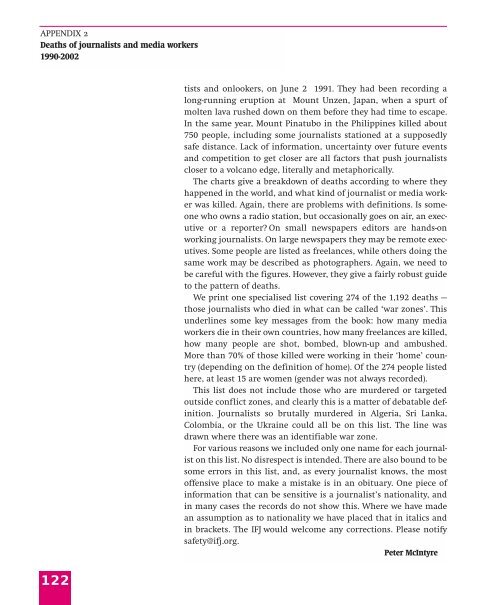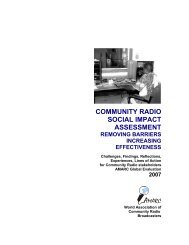Live News - A Survival Guide - International Federation of Journalists
Live News - A Survival Guide - International Federation of Journalists
Live News - A Survival Guide - International Federation of Journalists
- No tags were found...
You also want an ePaper? Increase the reach of your titles
YUMPU automatically turns print PDFs into web optimized ePapers that Google loves.
APPENDIX 2Deaths <strong>of</strong> journalists and media workers1990-2002tists and onlookers, on June 2 1991. They had been recording along-running eruption at Mount Unzen, Japan, when a spurt <strong>of</strong>molten lava rushed down on them before they had time to escape.In the same year, Mount Pinatubo in the Philippines killed about750 people, including some journalists stationed at a supposedlysafe distance. Lack <strong>of</strong> information, uncertainty over future eventsand competition to get closer are all factors that push journalistscloser to a volcano edge, literally and metaphorically.The charts give a breakdown <strong>of</strong> deaths according to where theyhappened in the world, and what kind <strong>of</strong> journalist or media workerwas killed. Again, there are problems with definitions. Is someonewho owns a radio station, but occasionally goes on air, an executiveor a reporter? On small newspapers editors are hands-onworking journalists. On large newspapers they may be remote executives.Some people are listed as freelances, while others doing thesame work may be described as photographers. Again, we need tobe careful with the figures. However, they give a fairly robust guideto the pattern <strong>of</strong> deaths.We print one specialised list covering 274 <strong>of</strong> the 1,192 deaths —those journalists who died in what can be called ‘war zones’. Thisunderlines some key messages from the book: how many mediaworkers die in their own countries, how many freelances are killed,how many people are shot, bombed, blown-up and ambushed.More than 70% <strong>of</strong> those killed were working in their ‘home’ country(depending on the definition <strong>of</strong> home). Of the 274 people listedhere, at least 15 are women (gender was not always recorded).This list does not include those who are murdered or targetedoutside conflict zones, and clearly this is a matter <strong>of</strong> debatable definition.<strong>Journalists</strong> so brutally murdered in Algeria, Sri Lanka,Colombia, or the Ukraine could all be on this list. The line wasdrawn where there was an identifiable war zone.For various reasons we included only one name for each journaliston this list. No disrespect is intended. There are also bound to besome errors in this list, and, as every journalist knows, the most<strong>of</strong>fensive place to make a mistake is in an obituary. One piece <strong>of</strong>information that can be sensitive is a journalist’s nationality, andin many cases the records do not show this. Where we have madean assumption as to nationality we have placed that in italics andin brackets. The IFJ would welcome any corrections. Please notifysafety@ifj.org.Peter McIntyre122
















